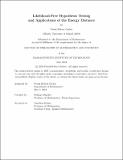| dc.description.abstract | This thesis studies questions in nonparametric testing and estimation that are inspired by machine learning. One of the main problems of our interest is likelihood-free hypothesis testing: given three samples X, Y and Z with sample sizes n, n and m respectively, one must decide whether the distribution of Z is closer to that of X or that of Y . We fully characterize the problem’s sample complexity for multiple distribution classes and with high probability. We uncover connections to two-sample, goodness-of-fit and robust testing, and show the existence of a trade-off of the form mn ≍ k/ε^4, where k is an appropriate notion
of complexity and ε is the total variation separation between the distributions of X and Y . We generalize our problem to allow Z to come from a mixture of the distributions of X and Y , and propose a kernel-based test for its solution, and also verify the existence of a trade-off between m and n on experimental data from particle physics. In addition, we demonstrate that the family of “classifier accuracy” tests are not only popular in practice but also provably near-optimal, recovering and simplifying a multitude of classical and recent results. Finally, we study affine classifiers as a tool for estimation and testing, with the key technical tool being a connection to the energy distance. In particular, we propose a density estimation routine based on minimizing the generalized energy distance, targeting smooth densities and Gaussian mixtures. We interpret our results in terms of half-space separability over these classes, and derive analogous results for discrete distributions. As a consequence we deduce that any two discrete distributions are well-separated by a half-space, provided their support is embedded as a packing of a high-dimensional unit ball. We also scrutinize two recent applications of the energy distance in the two-sample testing literature. | |
